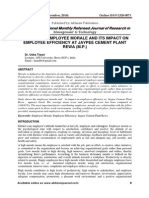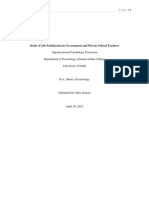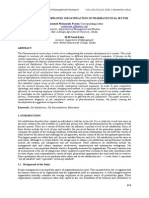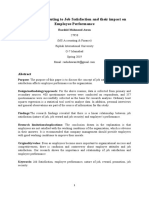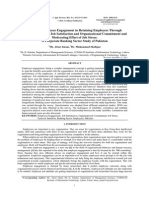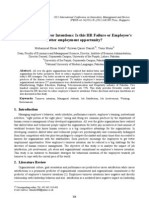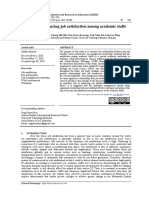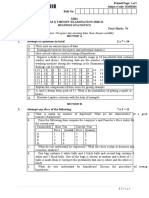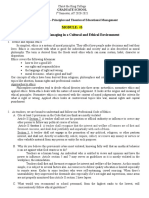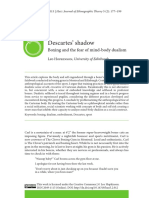08-07-2021-1625743715-6-Impact - Ijrbm-1. Ijrbm - Impact of Job Satisfaction On Employee Performance A Comparative Analysis
08-07-2021-1625743715-6-Impact - Ijrbm-1. Ijrbm - Impact of Job Satisfaction On Employee Performance A Comparative Analysis
Uploaded by
Impact JournalsCopyright:
Available Formats
08-07-2021-1625743715-6-Impact - Ijrbm-1. Ijrbm - Impact of Job Satisfaction On Employee Performance A Comparative Analysis
08-07-2021-1625743715-6-Impact - Ijrbm-1. Ijrbm - Impact of Job Satisfaction On Employee Performance A Comparative Analysis
Uploaded by
Impact JournalsOriginal Title
Copyright
Available Formats
Share this document
Did you find this document useful?
Is this content inappropriate?
Copyright:
Available Formats
08-07-2021-1625743715-6-Impact - Ijrbm-1. Ijrbm - Impact of Job Satisfaction On Employee Performance A Comparative Analysis
08-07-2021-1625743715-6-Impact - Ijrbm-1. Ijrbm - Impact of Job Satisfaction On Employee Performance A Comparative Analysis
Uploaded by
Impact JournalsCopyright:
Available Formats
IMPACT: International Journal of Research in
Business Management (IMPACT: IJRBM);
ISSN(Print): 2347-4572; ISSN(Online): 2321-886X
Vol. 9, Issue 7, Jul 2021, 1–6
© Impact Journals
IMPACT OF JOB SATISFACTION ON EMPLOYEE PERFORMANCE: A COMPARATIVE
ANALYSIS
Itishree Mohanty
Associate Professor & Admin In-Charge, Kanak Manjari Institute of Pharmaceutical Sciences, Chhend, Rourkela-769015
Received: 06 Jul 2021 Accepted: 07 Jun 2021 Published: 08 Jun 2021
ABSTRACT
The success of any organisation largely depends on the employees job satisfaction when an employee get satisfied for his/her
reward then definitely he or she can contribute better for organisation. Because job satisfaction is an important concern of
professional commitments. There are various factors that bring the job satisfaction but at the same time, the lack of them is
responsible job dissatisfaction. Employee’s job satisfaction is very essential concerning about the company’s constant growth.
So the job satisfaction of the employees is much more important than other components of the organisation. As we know, the
behaviour of employees depending on their level of job satisfaction that will affect the functioning and activities of the
organisations progress. Job satisfaction may serve as an indicator of organisational activities and its evaluation system will
boost the performance of employees as well as organisations. Employee performance is an instrumental tool to organisational
growth and profitability which is a major challenge in organisational management. The current study find out the level of job
satisfaction of both public and private organisation employees where people and Government increasing their concern about
privatisation. Moreover, Job satisfaction is a complex matter as it depends on various factors like work environment, various
policies related to job and intellectual realities etc
KEYWORDS: Employee, Job, Performance, Productivity and Satisfaction etc
INTRODUCTION
Job satisfaction is a pleasurable emotional response of a person to his current situation that may be linked to performance
and organisational productivity etc. As we know dissatisfaction employees are prone to absenteeism and excessive
turnover where as worker satisfaction may improve productivity, performance, creativity, enhance commitment and reduce
employee turnover. In an organisation, job satisfaction is crucial that desires its workforce to be productive. In these
competitive times, organisations are being faced with lots of burning issues in regards employee performance
enhancement. By creating motivational measures among the employees that are capable of enhancing employee job
satisfaction is playing vital role to every organisation. Moreover, the physical environment where employee works has a
great deal on determining level of employee job satisfaction on performance of an employee. As we know performance and
productivity of an employee is seen an issue of momentous vitality for employers, managers and the entire organisation as
well. Employee performance embodies all encompassing belief of the personnel in relation their conduct that aids in the
direction of the achievement of the organisation.
Due to persistent competition among different organisation, employers have realise the significance of employee
performance so as to strive in today’s global market with the realisation that as employee performance increases so does
Impact Factor(JCC): 5.4223 – This article can be downloaded from www.impactjournals.us
2 Itishree Mohanty
the firm’s overall performance along with profitability also rises .Today, most of employees have a high degree of job
dissatisfaction that creates attitudes that are not desirable on the job which in turn degenerate their performance ability in
their work place. Employees that realise perceived equity have higher chances for job satisfaction that lead lower intention
to leave as well as leading to higher level of commitment to the organisation. In an organisational progression employee
performance is contributory and considered as the foremost business assets that expedite the regular accomplishments and
task of an establishment. Employer’s ability to comprehend employee’s satisfaction level and attitude of work as it relates
to the level of perceived equality and how the physical work environment influence that will impact greatly on employee
productivity and performance. Employee performance is a challenging task in management of an organisation, devising an
operational method to motivate an individual employee to deliver qualitative job performance as well as the organisational
competency level that is the central objective of every business organisation.
In a simple way we can say job satisfaction is nothing but employee satisfaction that is linked with the aptitude,
attitude and general behaviour of a person towards their job. It is very clear that the multidimensional psychological
responses of a person towards their job give them happiness. So for this, there is a combination of multidimensional
psychological and personal responses such as cognitive, affective and behavioural components affect one’s job satisfaction.
Besides working environment and promotional opportunities, the other main contributors of job satisfaction are age, gender
and tenure etc. Furthermore, appreciation of the work done by any employee also creates job satisfaction. For any human
being, a job is a basic need to meet the day to day expenses so satisfaction with the job leads an employee towards family
satisfaction also. Adopting effective way to motivate employees to achieve and deliver higher job performance as well as
increase the organisational competitiveness. As the employees are consider as the major business resources that facilitate
day-to-day activities and operations of an organisation so for this in order to achieve higher employee’s performance ,
effective motivational tools should be adopted by managers of organisations because performance of employees determine
the level of organisational performance.
LITERATURE REVIEW
Some recent research works were included in this section as evidence in relation to job satisfactions of employees:
Zafarullah Sahito and Pertti Vaisanen (2016) observed in their study that the job satisfaction level and its
dimensions of teacher educators – who are working at the departments, faculties and institutes of education. The observed
staff members to cope with their problems as they work for their satisfaction and to bring radical reforms through proper
implementation of policies and procedures , that will lead them towards quality education in their respective institutions.
Mohammed Inuwa (2017) in his study adopts job equity as an independent variable and employee performance as
a dependent variable with the aim analysing how perceived job equity enhances employee performance . Moreover, this
paper will serve as a guide towards ensuring organisational justice and also contribute to the field organisational behaviour
and management. According to him job equity plays a great role in enhancing employee’s performance in the work place.
Another survey administered by Salma (2012) from September 2010 to December 2010 on 105 full-time
academic staff from two public and two private universities in Pakistan show that, private university lecturers were more
contended with their work than public university lecturers. However, both groups of lecturers exhibited significant
variation in the level of overall job satisfaction they derived from their jobs in terms of pay, supervision, relationship with
colleagues, promotion and job security. The private university lecturers were more satisfied with pay, promotion and
NAAS Rating: 3.09– Articles can be sent to editor@impactjournals.us
Impact of Job Satisfaction on Employee Performance: A Comparative Analysis 3
supervision. However, except for job security and relationship with coworkers, the majority of public university lecturers
were found to be dissatisfied with other aspects. The findings failed to establish a relationship between job satisfaction and
turnover
Hassan Abubakar Indris and ABD Rahim Romle (2015) in their study examine the relationship between intrinsic
factors and job satisfaction among the lectures of Bauchi State University Gadau, Nigeria. The Findings reveal that there is
a positive and significant relatuinship between intrinsic factors and job satisfaction where responsibility , work itself are
positively related to job satisfaction and found that staff training needs to be upgraded and improved in order to increase
the level of job satisfaction of lecturers of Bauchi State University Gadau, Nigeria.
Mohammed Inuwa and Abdullahi Muhammad (2016) in their study examines the impact of job satisfaction on the
performance of non-academic staff of Bauchi State University Gadau , Nigeria with physical working environment as the
moderator variable. The non-academic staff of Bauchi State University play an important role towards achieving the goals
and target of the University, which makes it important to conduct the study and device a means that will further enhance
their performance. On significance, the study will serve as a policy guide to the management of the Nigerian Universities
in areas relating to employee performance improvement and it will also further make an impetus the field of organisational
behaviour and human resource management.
NEED OF THE STUDY
The study is limited to the workers of public sector as well as private companies and therefore the findings of the study
cannot be extended to other areas. Results of the study may not be generalised as one of the major factors limiting the study
is the fact that is conducted in a single geographical area and the sampling size is not large enough to validate the study.
Objectives
To find out whether there is a relationship between job satisfaction and employee performance among employees of both
public and private sectors.
METHODOLOGY
Data Source and Method of collection
The primary source includes observation in depth interview with different grade of management, the people of the
community around which the company operates of both private and public sector. In this present study, a self developed
questionnaire in the form of statements also used as the tool for primary data collection. And from leaflets, magazines and
journal in relate to this, secondary data were collected.
Sample size and Sampling
The collected data was analyzed appropriately. The researcher study is regarding Job satisfaction on employee
performance. For the purpose of this study, the samples are selected from different strata of employees on random basis.
The sample consists of 40 respondents from different hierarchy levels in different department of both private and public
organisation respectively. Proper attention has been paid in selection of the sample.
Impact Factor(JCC): 5.4223 – This article can be downloaded from www.impactjournals.us
4 Itishree Mohanty
Tools and Techniques used
The important statistical tools and techniques used in the study: Mean, Standard deviation and t-test etc.
RESULTS AND DISCUSSION
The study found out the job satisfaction level of both private and public organisation employees. This is very relevant issue
in a current situation where job satisfaction as a complex matter that depends on various factors like working environment,
issues and policies related to job and professional realities etc. The results obtained from this research work can be
represented in the following tables:
Table 1: Public Organisation Employees’ Attitude towards Job at a Glance
Sl No. Public Organisation Employees
Cumulative Score(X1) (X1- X1 ) (X1- X1 )2
1. 73 5.4 29.16
2. 65 -2.6 6.76
3. 68 0.4 0.16
4. 48 -19.6 384.16
5. 51 -16.6 275.56
6. 76 8.4 70.56
7. 75 7.4 54.76
8. 74 6.4 40.96
9. 87 19.4 376.36
10. 65 -2.6 6.76
11. 72 4.4 19.6
12. 71 3.4 11.56
13. 64 -3.6 12.86
14. 45 -22.6 510.76
15. 74 6.4 40.96
16. 73 5.4 29.16
17. 56 -11.6 134.56
18. 68 0.4 0.16
19. 76 8.4 70.56
20. 71 3.4 11.56
∑ X1= 1352/20
= 67.6 ∑(X1- X1 )2 =2086.84
Table 2: Private Organisation Employees’ Attitude towards Job at a Glance
Sl No. Private Organisation Employees
Cumulative Score(X1) (X1- X1 ) (X1- X1 )2
1. 78 17.9 320.41
2. 65 4.9 24.01
3. 71 10.9 118.81
4. 44 -16.1 259.21
5. 54 -6.1 37.21
6. 39 -21.1 445.21
7. 47 -13.1 171.61
8. 56 -4.1 16.81
9. 73 12.9 166.41
10. 76 15.9 252.81
11. 62 1.9 3.61
12. 66 5.9 34.81
13. 58 -2.1 4.41
14. 38 -22.1 488.41
NAAS Rating: 3.09– Articles can be sent to editor@impactjournals.us
Impact of Job Satisfaction on Employee Performance: A Comparative Analysis 5
Table 2: Contd.,
15. 60 -0.1 0.01
16. 77 16.9 285.61
17. 47 -13.1 171.61
18. 55 -5.1 26.01
19. 72 11.9 141.61
20. 64 3.9 15.21
∑ X1= 1202/20
∑(X1- X1 )2 = 2983.8
= 60.1
Table 2: Statistical Test of Job Satisfaction of Both Public and Private Organisation
Sample Type Sample Size Mean Standard Deviation Degree of Freedom Level of Frequency t-Value
Public 20 67.6 10.4801
38 0.05 2.05
Private 20 60.1 12.531
From this research work, the following results obtained. The result indicates that, the t- value of the job
satisfaction of the employees was 2.05 that were higher than the tabulated value. So our null hypothesis was rejected. That
means there was relation between the attitude of private and public employees. Both are satisfied with their respective
organisation. As job satisfaction has a wide scope of implication such as working environment, policy matter, context of
job etc. So policy maker in both organisations need to be concentrate to design an effective policy by considering
employee motivation, promotion, sponsorship etc. Though there was no mentionable difference between job satisfaction of
both public and private employees but somewhat their attitude was differ.
SUGGESTION
• Policy makers of both government and private organisation need to be concentrating to make good policy and that
should be really effective one.
• Continuous training for the employees
• Design better policies that incorporate employee in decision making as well as standardize working conditions.
• Give attention in order to increase higher job satisfaction and motivation of employees at all levels.
CONCLUSIONS
Working environment, policy matters and job content etc. are wide area of job satisfaction implication. High level of
employee performance denotes to be more efficient and effective in carrying out their respective roles. This study will
make organisations to recognise the significance of employees in the workplace and ensure that employees with their jobs
are highly satisfied. Moreover, both private and public organisations should always think about what compensation
packages motivate and excite their employees to get optimum performance and high productivity from them. Statistical test
of job satisfaction of both private and public organisation employees shows that as there was no such difference between
job satisfaction of both private and public employees but there was attitude differences between them. But as the findings
revealed some gap between private and public employees that will help policy makers of both organisations to develop
employee friendly policy in the future.
Impact Factor(JCC): 5.4223 – This article can be downloaded from www.impactjournals.us
6 Itishree Mohanty
REFERENCES
1. Abubakar H. I. and Romle ABD R. (2015),’ Intrinsic Factors of Job Satisfaction Among Lectures of Bauchi State
University ,Gadau, Nigeria’, International Journal of Administration and Governance, 1(4),pp.91-87.
2. Inuwa M. (2017), ‘Relationship between Job Equity and Performance of Employee: A Literature Review’,
International Journal of Business and Management Future, 1(1), pp.14-21.
3. Inuwa M. and Muhammad A. (2016),’ Impact of Job Satisfaction on Performance of Non- Academic Staff of
Bauchi State University Gadau: The Moderating Effect of Physical Working Environment’, International Journal
of Economics and Business Management, 2(8), pp. 60-77.
4. Khalid S. (2012),’Job satisfaction among Academic Staff: A Comparative Analysis between Public and Private
Universities of Punjab’, Pakistan. International journal of Business and Management, 17(1),pp. 910- 928.
5. Sahito, Z. and Vaisanen, P.(2016), ‘Dimensions of Job Satisfaction of Teacher Educators : A Qualitative Study of
the Universities of Sindh Province of Pakistan ‘,Journal of Curriculum and Teaching , 5(2) , pp.13-54.
NAAS Rating: 3.09– Articles can be sent to editor@impactjournals.us
You might also like
- Impact of Employee Motivation On Organizational Performance MN Google PDFDocument8 pagesImpact of Employee Motivation On Organizational Performance MN Google PDFGina WaelNo ratings yet
- Sample Implementation PlanDocument4 pagesSample Implementation Plandinky deanNo ratings yet
- Impact of Job Satisfaction of Employee's Performance in HIE'sDocument73 pagesImpact of Job Satisfaction of Employee's Performance in HIE'sDhani Shanker ChaubeyNo ratings yet
- An Analysis of Job Satisfaction of Employees: Palak SharmaDocument4 pagesAn Analysis of Job Satisfaction of Employees: Palak Sharmakamaliwaran.mbaNo ratings yet
- The Impact of Job Satisfaction, Job Attitude and Equity On Employee PerformanceDocument7 pagesThe Impact of Job Satisfaction, Job Attitude and Equity On Employee PerformanceRifqa SatwikaNo ratings yet
- Impact of Job Satisfaction On Employee PerformanceDocument6 pagesImpact of Job Satisfaction On Employee Performancerashid awanNo ratings yet
- Impact of Job Satisfaction On Employee Performance NewDocument12 pagesImpact of Job Satisfaction On Employee Performance Newrashid awanNo ratings yet
- HRM CAMPUS ExperienceDocument15 pagesHRM CAMPUS ExperiencemadhurikachintaNo ratings yet
- The Effect of Mutation, Promotion and Job Satisfaction On Employee Performance of Plantation Companies in MedanDocument11 pagesThe Effect of Mutation, Promotion and Job Satisfaction On Employee Performance of Plantation Companies in MedanaijbmNo ratings yet
- Part B 1sp17mba20Document71 pagesPart B 1sp17mba20jeevan mathiNo ratings yet
- 16IJHRMRAPR201916Document10 pages16IJHRMRAPR201916TJPRC PublicationsNo ratings yet
- Science and Business: Job Satisfaction of The Employees of Islami Bank Bangladesh LTD: A Study On Lakshmipur DistrictDocument15 pagesScience and Business: Job Satisfaction of The Employees of Islami Bank Bangladesh LTD: A Study On Lakshmipur DistrictTanzia RahmanNo ratings yet
- Literature Review On Job Satisfaction and Organizational CommitmentDocument9 pagesLiterature Review On Job Satisfaction and Organizational CommitmentafdtbbhtzNo ratings yet
- RESEARCH METHOD (THE REAL ASSIGNMENT) Pemimpin UpdatedDocument10 pagesRESEARCH METHOD (THE REAL ASSIGNMENT) Pemimpin UpdatedLinda DahlanNo ratings yet
- Morale ProjectDocument7 pagesMorale ProjectmanaskollamNo ratings yet
- 1 TO 5Document51 pages1 TO 5sirtitcombe1No ratings yet
- Hope JSSDocument33 pagesHope JSSs9528No ratings yet
- Review of LiteratureDocument13 pagesReview of LiteratureVidya B NNo ratings yet
- AJBMR 19 23i1n9a13aDocument11 pagesAJBMR 19 23i1n9a13atafakharhasnainNo ratings yet
- Organizational BehaviorDocument14 pagesOrganizational Behaviorkakulsharma2005No ratings yet
- Impact of Job Satisfaction On Employee Performance 2Document13 pagesImpact of Job Satisfaction On Employee Performance 2rashid awanNo ratings yet
- Ms. Abeer Imam, Dr. Muhammad ShafiqueDocument15 pagesMs. Abeer Imam, Dr. Muhammad ShafiqueLata SinghNo ratings yet
- ArticlesDocument4 pagesArticlesSPOOKY TRIONo ratings yet
- Job Satisfaction and Employee Performanc PDFDocument20 pagesJob Satisfaction and Employee Performanc PDFNatasha DudaniNo ratings yet
- The Effects of Interpersonal Relationship On Employees' Job Satisfaction: The Case of Education Department, Hawassa City AdministrationDocument7 pagesThe Effects of Interpersonal Relationship On Employees' Job Satisfaction: The Case of Education Department, Hawassa City Administrationbelhsensana99No ratings yet
- Organizational SupportDocument13 pagesOrganizational SupportHenry DP SinagaNo ratings yet
- Job SatisfactionDocument11 pagesJob SatisfactionGaurav VohraNo ratings yet
- Research Paper Job Satisfaction PDFDocument6 pagesResearch Paper Job Satisfaction PDFvehysad1s1w3100% (1)
- Employee's Turnover Intentions: Is This HR Failure or Employee's Better Employment Opportunity?Document6 pagesEmployee's Turnover Intentions: Is This HR Failure or Employee's Better Employment Opportunity?Priya VenkataramanNo ratings yet
- Effect of Employee Satisfaction On Intrapreneurship: An Analysis From Service Industry of PakistanDocument9 pagesEffect of Employee Satisfaction On Intrapreneurship: An Analysis From Service Industry of PakistanMuhammadarslan73No ratings yet
- 32c1 PDFDocument7 pages32c1 PDFshravasti munwarNo ratings yet
- SUNARNODocument10 pagesSUNARNODel Pirunis Al MeohainistiNo ratings yet
- Variables Influencing Employee Performance in Organization.Document10 pagesVariables Influencing Employee Performance in Organization.Moshiur Tusher75% (4)
- Saad ProjectDocument15 pagesSaad ProjectAmuhammed ZaidNo ratings yet
- Impact of Job Satisfaction Ndulue Et Al.Document11 pagesImpact of Job Satisfaction Ndulue Et Al.Ayasha Farica Meidina100% (1)
- Employee Motivation EditDocument29 pagesEmployee Motivation EdityellowishmustardNo ratings yet
- SynopsisDocument7 pagesSynopsiskrithikusumaNo ratings yet
- What Is Job Satisfaction ?Document6 pagesWhat Is Job Satisfaction ?viaraNo ratings yet
- Wow Research 1Document7 pagesWow Research 1exequiel mejiaNo ratings yet
- ALEXDocument71 pagesALEXAlex ShineNo ratings yet
- The Impact of Job Satisfaction and Motivation at Workplace PDFDocument14 pagesThe Impact of Job Satisfaction and Motivation at Workplace PDFmaksud RahmanNo ratings yet
- No PrpductDocument6 pagesNo PrpductChudhary JunaidNo ratings yet
- Literature Review On Factors Influencing Job SatisfactionDocument8 pagesLiterature Review On Factors Influencing Job Satisfactionea20cqytNo ratings yet
- The Effect of Work Discipline and Work Motivation On Job Satisfaction and Its Impact On The Performance of Government EmployeesDocument10 pagesThe Effect of Work Discipline and Work Motivation On Job Satisfaction and Its Impact On The Performance of Government EmployeesaijbmNo ratings yet
- Internasional KK Terhadap KinerjaDocument22 pagesInternasional KK Terhadap KinerjaAkbar RamadhanNo ratings yet
- Impact of Employees Motivation On Organizational EffectivenessDocument5 pagesImpact of Employees Motivation On Organizational EffectivenessChudhary JunaidNo ratings yet
- Introduction (Busre)Document3 pagesIntroduction (Busre)sagunlovelyn825No ratings yet
- The Implications of Employees Turnover in Nigerian Higher EducationDocument10 pagesThe Implications of Employees Turnover in Nigerian Higher EducationPrince LovetNo ratings yet
- Kokila MbaDocument56 pagesKokila MbaSanthiya AnanthNo ratings yet
- Chapter 1-5Document31 pagesChapter 1-5yusufNo ratings yet
- F0801013539 PDFDocument5 pagesF0801013539 PDFlynnthuNo ratings yet
- Synopsis1 123174Document11 pagesSynopsis1 123174infotechedge10No ratings yet
- ArjunDocument7 pagesArjunarjunkumar.689101No ratings yet
- 0rder 312 Activity 5 OrgDocument8 pages0rder 312 Activity 5 Orgjoshua chegeNo ratings yet
- Project Report: Organization BehaviorDocument15 pagesProject Report: Organization BehaviorSharad PyakurelNo ratings yet
- Ej 1256319Document7 pagesEj 1256319Jennifer EscalaNo ratings yet
- Effects of Job Satisfaction On Employees Motivation & Turn Over IntentionsDocument21 pagesEffects of Job Satisfaction On Employees Motivation & Turn Over IntentionsJayson AceNo ratings yet
- IJCRT2008392Document9 pagesIJCRT2008392thokarsakambariNo ratings yet
- Research Project Final Dr. Zeeshan Ali SapID 20845Document16 pagesResearch Project Final Dr. Zeeshan Ali SapID 20845Zeeshan AliNo ratings yet
- Employee Satisfaction ThesisDocument14 pagesEmployee Satisfaction ThesisdeepNo ratings yet
- Enhancing Success for Performance Management in the Public SectorFrom EverandEnhancing Success for Performance Management in the Public SectorNo ratings yet
- 12-11-2022-1668238142-6-Impact - Ijrbm-01.Ijrbm Smartphone Features That Affect Buying Preferences of StudentsDocument7 pages12-11-2022-1668238142-6-Impact - Ijrbm-01.Ijrbm Smartphone Features That Affect Buying Preferences of StudentsImpact JournalsNo ratings yet
- 19-11-2022-1668838190-6-Impact - Ijrhal-3. Ijrhal-A Study of Emotional Maturity of Primary School StudentsDocument6 pages19-11-2022-1668838190-6-Impact - Ijrhal-3. Ijrhal-A Study of Emotional Maturity of Primary School StudentsImpact JournalsNo ratings yet
- 09-12-2022-1670567569-6-Impact - Ijrhal-05Document16 pages09-12-2022-1670567569-6-Impact - Ijrhal-05Impact JournalsNo ratings yet
- 19-11-2022-1668837986-6-Impact - Ijrhal-2. Ijrhal-Topic Vocational Interests of Secondary School StudentsDocument4 pages19-11-2022-1668837986-6-Impact - Ijrhal-2. Ijrhal-Topic Vocational Interests of Secondary School StudentsImpact JournalsNo ratings yet
- 14-11-2022-1668421406-6-Impact - Ijrhal-01. Ijrhal. A Study On Socio-Economic Status of Paliyar Tribes of Valagiri Village AtkodaikanalDocument13 pages14-11-2022-1668421406-6-Impact - Ijrhal-01. Ijrhal. A Study On Socio-Economic Status of Paliyar Tribes of Valagiri Village AtkodaikanalImpact JournalsNo ratings yet
- 28-10-2022-1666956219-6-Impact - Ijrbm-3. Ijrbm - Examining Attitude ...... - 1Document10 pages28-10-2022-1666956219-6-Impact - Ijrbm-3. Ijrbm - Examining Attitude ...... - 1Impact JournalsNo ratings yet
- 12-10-2022-1665566934-6-IMPACT - IJRHAL-2. Ideal Building Design y Creating Micro ClimateDocument10 pages12-10-2022-1665566934-6-IMPACT - IJRHAL-2. Ideal Building Design y Creating Micro ClimateImpact JournalsNo ratings yet
- 22-09-2022-1663824012-6-Impact - Ijranss-5. Ijranss - Periodontics Diseases Types, Symptoms, and Its CausesDocument10 pages22-09-2022-1663824012-6-Impact - Ijranss-5. Ijranss - Periodontics Diseases Types, Symptoms, and Its CausesImpact JournalsNo ratings yet
- 29-08-2022-1661768824-6-Impact - Ijrhal-9. Ijrhal - Here The Sky Is Blue Echoes of European Art Movements in Vernacular Poet Jibanananda DasDocument8 pages29-08-2022-1661768824-6-Impact - Ijrhal-9. Ijrhal - Here The Sky Is Blue Echoes of European Art Movements in Vernacular Poet Jibanananda DasImpact JournalsNo ratings yet
- 19-09-2022-1663587287-6-Impact - Ijrhal-3. Ijrhal - Instability of Mother-Son Relationship in Charles Dickens' Novel David CopperfieldDocument12 pages19-09-2022-1663587287-6-Impact - Ijrhal-3. Ijrhal - Instability of Mother-Son Relationship in Charles Dickens' Novel David CopperfieldImpact JournalsNo ratings yet
- 21-09-2022-1663757902-6-Impact - Ijranss-4. Ijranss - Surgery, Its Definition and TypesDocument10 pages21-09-2022-1663757902-6-Impact - Ijranss-4. Ijranss - Surgery, Its Definition and TypesImpact JournalsNo ratings yet
- 06-08-2022-1659783347-6-Impact - Ijrhal-1. Ijrhal - Concept Mapping Tools For Easy Teaching - LearningDocument8 pages06-08-2022-1659783347-6-Impact - Ijrhal-1. Ijrhal - Concept Mapping Tools For Easy Teaching - LearningImpact JournalsNo ratings yet
- 24-08-2022-1661313054-6-Impact - Ijranss-5. Ijranss - Biopesticides An Alternative Tool For Sustainable AgricultureDocument8 pages24-08-2022-1661313054-6-Impact - Ijranss-5. Ijranss - Biopesticides An Alternative Tool For Sustainable AgricultureImpact JournalsNo ratings yet
- 25-08-2022-1661424544-6-Impact - Ijranss-6. Ijranss - Parametric Metric Space and Fixed Point TheoremsDocument8 pages25-08-2022-1661424544-6-Impact - Ijranss-6. Ijranss - Parametric Metric Space and Fixed Point TheoremsImpact JournalsNo ratings yet
- The Analysis On Environmental Effects of Land Use and Land Cover Change in Liuxi River Basin of GuangzhouDocument16 pagesThe Analysis On Environmental Effects of Land Use and Land Cover Change in Liuxi River Basin of GuangzhouImpact JournalsNo ratings yet
- Assignment About Swot AnalysisDocument4 pagesAssignment About Swot AnalysisAvila SimonNo ratings yet
- Blooms Taxonomy For Table of SpecificationDocument3 pagesBlooms Taxonomy For Table of SpecificationReizel Jane Pascua100% (5)
- Werabe UniversityDocument32 pagesWerabe UniversityabatmaryeNo ratings yet
- Best Practices Guide:: For Resort Development in British ColumbiaDocument115 pagesBest Practices Guide:: For Resort Development in British Columbiakomal sharmaNo ratings yet
- Assignment For IBSDocument14 pagesAssignment For IBSahmedsmateNo ratings yet
- Technical Report GuidanceDocument8 pagesTechnical Report GuidancemigelNo ratings yet
- Mba 1 Sem Business Statistics Rmb104 2021Document2 pagesMba 1 Sem Business Statistics Rmb104 2021Udita SinghNo ratings yet
- Module 6 - ExcelDocument9 pagesModule 6 - ExcelNiharika MathurNo ratings yet
- Module 4Document24 pagesModule 4John Rhenard LouiseNo ratings yet
- Psy Ass Midterm ReviewerrDocument9 pagesPsy Ass Midterm ReviewerrMARIANO, AIRA MAE A.No ratings yet
- Management GamesDocument2 pagesManagement GamesTulasi Nadh MtnNo ratings yet
- Educ 206 Module For Chapter 3Document5 pagesEduc 206 Module For Chapter 3TeacherBechay VlogNo ratings yet
- Hopkinson - 2015 - Descartes' ShadowDocument23 pagesHopkinson - 2015 - Descartes' ShadowRaoni GiraldinNo ratings yet
- Artikel JPS SubmitDocument10 pagesArtikel JPS SubmitLuh SukariasihNo ratings yet
- IGNOU MBA MS-10 SolvedDocument15 pagesIGNOU MBA MS-10 SolvedtobinsNo ratings yet
- FORENSIC CHEMISTRY IntroductionDocument2 pagesFORENSIC CHEMISTRY IntroductionTrisha Mae Kitong100% (1)
- Subtitling: Language Learners' Needs vs. Audiovisual Market NeedsDocument12 pagesSubtitling: Language Learners' Needs vs. Audiovisual Market NeedsjNo ratings yet
- Proposal FixxxDocument37 pagesProposal FixxxfaruqNo ratings yet
- Book Proposal HandoutDocument3 pagesBook Proposal HandoutErinJenneNo ratings yet
- Annexure D3 - DPR Main Report Dated 28-12-2021Document39 pagesAnnexure D3 - DPR Main Report Dated 28-12-2021Ajay sai kumarNo ratings yet
- Patanjali ProjectDocument7 pagesPatanjali ProjectNidhiNo ratings yet
- 09 Earned Value AnalysisDocument25 pages09 Earned Value AnalysisamaliaNo ratings yet
- Curriculum Vitae: Personal DetailsDocument3 pagesCurriculum Vitae: Personal DetailsCynthia Rizka RianiNo ratings yet
- Sequential and Nonsequential Monte Carlo in Assessing Reliability Performance of Distribution NetworkDocument6 pagesSequential and Nonsequential Monte Carlo in Assessing Reliability Performance of Distribution Networknabihah rusyda 96No ratings yet
- Executive Summary SCIENCEDocument68 pagesExecutive Summary SCIENCEJyotishmoi BoraNo ratings yet
- Institutionalizing EthicsDocument19 pagesInstitutionalizing EthicsSarada NagNo ratings yet
- Social Science & Medicine: April K. Hermstad, Deanne W. Swan, Michelle C. Kegler, J.K. Barnette, Karen GlanzDocument9 pagesSocial Science & Medicine: April K. Hermstad, Deanne W. Swan, Michelle C. Kegler, J.K. Barnette, Karen GlanzNur MelizzaNo ratings yet
- Shriya Jejani-Report On Women Entreprenurship Through VMMDocument38 pagesShriya Jejani-Report On Women Entreprenurship Through VMMvaishalirathod431No ratings yet
- Mantra Systems-PMS in The MDR-White Paper-Edition 3.1Document12 pagesMantra Systems-PMS in The MDR-White Paper-Edition 3.1elias.daood15No ratings yet














